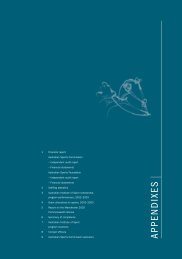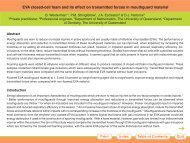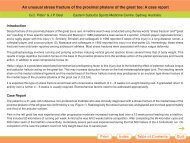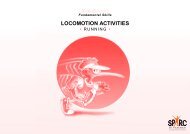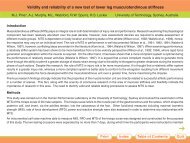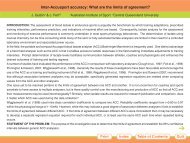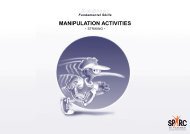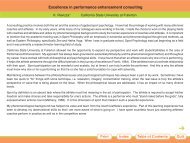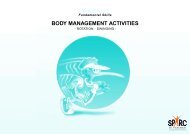Bat design and ball exit velocity in baseball - Australian Sports ...
Bat design and ball exit velocity in baseball - Australian Sports ...
Bat design and ball exit velocity in baseball - Australian Sports ...
You also want an ePaper? Increase the reach of your titles
YUMPU automatically turns print PDFs into web optimized ePapers that Google loves.
Introduction<br />
<strong>Bat</strong> <strong>design</strong> <strong>and</strong> <strong>ball</strong> <strong>exit</strong> <strong>velocity</strong> <strong>in</strong> base<strong>ball</strong>: Implications for player safety<br />
R.L. Nicholls* , B.C. Elliott & K. Miller University of Western Australia<br />
Wooden bats have been used <strong>in</strong> base<strong>ball</strong> s<strong>in</strong>ce the found<strong>in</strong>g of the game <strong>in</strong> n<strong>in</strong>eteenth-century America. These bats are still exclusively used<br />
by professional players, <strong>and</strong> <strong>in</strong> the Olympic Games <strong>and</strong> World Championships. More durable metal bats were <strong>in</strong>troducted <strong>in</strong>to base<strong>ball</strong> <strong>in</strong><br />
1972, <strong>and</strong> are used <strong>in</strong> most non-professional <strong>and</strong> youth base<strong>ball</strong> leagues.<br />
Metal bats have been the subject of recent research as concerns arise over <strong>in</strong>creas<strong>in</strong>g <strong>ball</strong> <strong>exit</strong> <strong>velocity</strong> <strong>and</strong> player safety. The National Centre<br />
for Catastrophic <strong>Sports</strong> Injury Research ranked base<strong>ball</strong> n<strong>in</strong>th <strong>in</strong> nonfatal <strong>in</strong>juries to US collegiate athletes <strong>in</strong> 1997. However, base<strong>ball</strong> had the<br />
highest fatal <strong>in</strong>jury rate of the 13 men’s sports surveyed (0.63 fatal <strong>in</strong>juries per 100,000 participants), exceed<strong>in</strong>g that of gridiron <strong>and</strong> ice hockey<br />
(NCAA News, June 8, 1998). The US Consumer Product Safety Commission reported 14 fatalities <strong>in</strong> children from blunt impact by a base<strong>ball</strong><br />
to the head or chest between April 1994 <strong>and</strong> April 1995 (Van Amerongen, Rosen, W<strong>in</strong>nik & Horwitz, 1997).<br />
As the closest <strong>in</strong>fielder to the hitter, the pitcher is at greatest risk of be<strong>in</strong>g <strong>in</strong>jured by the batted-<strong>ball</strong>. In 1998, 375 Division I collegiate pitchers<br />
were struck by l<strong>in</strong>edrives (hard-hit, low-trajectory <strong>ball</strong>s). Such impact <strong>in</strong>juries comprise about 3% of all <strong>in</strong>juries to pitchers, <strong>and</strong> this rate has<br />
rema<strong>in</strong>ed relatively constant s<strong>in</strong>ce 1972 (Dick, 1999). However, <strong>in</strong>creas<strong>in</strong>g sophistication <strong>in</strong> metal bat <strong>design</strong> <strong>in</strong>dicates the risk to pitchers may<br />
be greater when fac<strong>in</strong>g hitters us<strong>in</strong>g metal bats. ’Ball <strong>exit</strong> <strong>velocity</strong> (BBV) for <strong>ball</strong>s hit with metal bats has been demonstrated higher than from<br />
wood bats (Bryant, Burkett, Chen, Krahenbuhl & Lu, 1977; Elliott, 1979). BBV values obta<strong>in</strong>ed from wood bats ranged between 39.62 - 44.17<br />
m/s (143 - 159 km/h). At a distance of 16.46 m, m<strong>in</strong>imum movement time for a pitcher to complete a protective motion aga<strong>in</strong>st a l<strong>in</strong>edrive is<br />
approximately 400 ms (Cassidy & Burton, 1989). This represents a ’safe’ BBV of approximately 42 m/s (151 km/h). Greenwald, Penna &<br />
Crisco (2001) quantified average <strong>ball</strong> <strong>exit</strong> <strong>velocity</strong> from metal bats as 47.61 m/s (171 km/h), with even high-school hitters achiev<strong>in</strong>g BBV<br />
exceed<strong>in</strong>g 160 km/h. It is evident <strong>ball</strong> <strong>exit</strong> speeds from metal bats present a particular danger to the pitcher.<br />
Differences <strong>in</strong> elastic or vibrational characteristics of the bat constituent material have been proposed as factors <strong>in</strong> the superior performance of<br />
metal bats (Ashley, 1991). However dur<strong>in</strong>g a high-speed impact, the base<strong>ball</strong> may be <strong>in</strong> contact with the bat for as little as 2 ms (Greenwald,<br />
Penna & Crisco, 2001). Adair (1994) estimated the impulse generated by a <strong>ball</strong> strik<strong>in</strong>g a bat held firmly <strong>in</strong> the h<strong>and</strong>s may take up to 8 ms to<br />
propagate from the po<strong>in</strong>t of impact <strong>in</strong> the barrel, to the h<strong>and</strong>s, <strong>and</strong> back to the impact po<strong>in</strong>t - by which time the <strong>ball</strong> will have already departed.<br />
These f<strong>in</strong>d<strong>in</strong>gs suggest factors beside bat material properties may affect <strong>ball</strong> <strong>exit</strong> <strong>velocity</strong>.<br />
Pr<strong>in</strong>t<br />
Index<br />
Table of Contents<br />
Quit
<strong>Bat</strong> <strong>design</strong> <strong>and</strong> <strong>ball</strong> <strong>exit</strong> <strong>velocity</strong> <strong>in</strong> base<strong>ball</strong>: Implications for player safety<br />
R.L. Nicholls* , B.C. Elliott & K. Miller University of Western Australia<br />
This study <strong>in</strong>vestigated the effect of bat <strong>design</strong> on l<strong>in</strong>edrive speed. The selection of wood or metal materials promotes considerable <strong>design</strong><br />
differences between bats. The greater density of alum<strong>in</strong>ium alloys means the bat must be shaped as a hollow tube to ma<strong>in</strong>ta<strong>in</strong> the same weight<br />
as a solid ash bat, whose mass is distributed throughout the implement, with a greater proportion of mass located <strong>in</strong> the hitt<strong>in</strong>g region (barrel).<br />
Resistance to angular acceleration is determ<strong>in</strong>ed by the distribution of bat mass with respect to its axis of rotation. As a first class lever rotat<strong>in</strong>g<br />
about the h<strong>and</strong>s aga<strong>in</strong>st the resistance of the barrel weight, for a given torque the “end-heavy” wood bat will achieve less angular acceleration<br />
than a metal bat. Such a bat also requires greater impulse to produce a change <strong>in</strong> bat speed, result<strong>in</strong>g <strong>in</strong> decreased l<strong>in</strong>ear <strong>velocity</strong> of the barrel,<br />
thereby impart<strong>in</strong>g less <strong>velocity</strong> to the <strong>ball</strong> (Noble, 1998; Hay; 1973).<br />
Statement of the Problem<br />
To develop effective st<strong>and</strong>ards for equipment <strong>and</strong> maximise player safety <strong>in</strong> base<strong>ball</strong>, the effect of bat <strong>design</strong> on <strong>ball</strong> <strong>exit</strong> <strong>velocity</strong> must be<br />
quantified. Metal bats are currently certified”“safe” before commercial sale us<strong>in</strong>g robotic sw<strong>in</strong>g test<strong>in</strong>g. The purpose of this study was to<br />
quantify the effect of bat weight distribution on <strong>ball</strong> <strong>exit</strong> <strong>velocity</strong> from metal <strong>and</strong> wood bats swung by high-performance hitters.<br />
Methods<br />
Base<strong>ball</strong> bats: One metal bat <strong>and</strong> one wood bat were selected for analysis. <strong>Bat</strong> specifications are listed <strong>in</strong> Table 1 (expressed <strong>in</strong> both SI <strong>and</strong><br />
empirical units as is traditional <strong>in</strong> base<strong>ball</strong>). <strong>Bat</strong>s were selected as representative of the length <strong>and</strong> mass of bats used <strong>in</strong> high school <strong>and</strong><br />
collegiate base<strong>ball</strong>. The metal bat was constructed from an alloy of heat-treated z<strong>in</strong>c, magnesium <strong>and</strong> alum<strong>in</strong>ium. The wood bat was a solid<br />
northern white ash bat. Although sold as conform<strong>in</strong>g to NCAA mass <strong>and</strong> length restrictions (which state the empirical length-to-weight differential<br />
must not exceed 3), the metal bat was approximately 30 g lighter than the certified weight. While the bats were virtually identical <strong>in</strong> length <strong>and</strong><br />
similar <strong>in</strong> mass, the primary difference between the two bats was the location of the centre of mass (CM). The theoretical po<strong>in</strong>t around which<br />
the mass of the metal bat was distributed was located us<strong>in</strong>g a knife-edge balance technique (Hay, 1973), <strong>and</strong> was found to be approximately<br />
5 cm closer to the h<strong>and</strong>le than that of the wood bat.<br />
Pr<strong>in</strong>t<br />
Index<br />
Table of Contents<br />
Quit
<strong>Bat</strong> <strong>design</strong> <strong>and</strong> <strong>ball</strong> <strong>exit</strong> <strong>velocity</strong> <strong>in</strong> base<strong>ball</strong>: Implications for player safety<br />
R.L. Nicholls* , B.C. Elliott & K. Miller University of Western Australia<br />
Table 1: Specifications of wood <strong>and</strong> metal base<strong>ball</strong> bats used <strong>in</strong> this study.<br />
<strong>Bat</strong> Length (m) Length (<strong>in</strong>.) Mass<br />
(kg)<br />
Mass<br />
(oz.)<br />
Empirical lengthweight<br />
differential<br />
Pr<strong>in</strong>t<br />
<strong>Bat</strong> centre of<br />
mass<br />
(balance<br />
po<strong>in</strong>t) (m)<br />
Wood 0.835 32.87 0.840 29.63 3.24 0.570 0.0637<br />
Metal 0.834 32.83 0.805 28.40 4.43 0.528 0.0698<br />
Index<br />
Diameter at<br />
widest po<strong>in</strong>t of<br />
bat barrel (m)<br />
Subjects: Informed consent was obta<strong>in</strong>ed from sixteen hitters from an <strong>Australian</strong> Base<strong>ball</strong> Federation summer base<strong>ball</strong> league. The subjects’<br />
mean age was 22.81 ± 4.58 years, height 1.77 ± 0.74 m <strong>and</strong> mass 83.06 ± 8.59 kg. A m<strong>in</strong>imum batt<strong>in</strong>g average of .300 from the 1999-2000<br />
season was required (mean .366 ± 0.04). Ten subjects were right-h<strong>and</strong>ed, six were left-h<strong>and</strong>ed.<br />
Data collection: All participants attended a familiarisation session at the <strong>in</strong>door hitt<strong>in</strong>g facility prior to film<strong>in</strong>g. <strong>Bat</strong>t<strong>in</strong>g practice was undertaken<br />
with the test bats <strong>in</strong> a net-mesh batt<strong>in</strong>g tunnel (3 m x 4 m x 26 m). Dur<strong>in</strong>g data collection, experienced pitchers were used to pitch base<strong>ball</strong>s to<br />
each subject from a distance of 10.67 m. The mean pitch <strong>velocity</strong> was 20.47 m/s, correspond<strong>in</strong>g to a speed of approximately 36 m/s over the<br />
regulation base<strong>ball</strong> pitch<strong>in</strong>g distance of 18.44 m, <strong>and</strong> representative of collegiate pitch<strong>in</strong>g speeds. Each subject hit with both wood <strong>and</strong> metal<br />
bats <strong>in</strong> a r<strong>and</strong>om order. Hitters were <strong>in</strong>structed to sw<strong>in</strong>g at pitches only <strong>in</strong> the mid-section of the strike zone, <strong>and</strong> practiced until they achieved<br />
a consistent pattern of l<strong>in</strong>edrives directed toward centrefield. Each subject was subsequently filmed until produc<strong>in</strong>g five l<strong>in</strong>edrives. Five to<br />
eight m<strong>in</strong>utes recovery were permitted between use of each bat.<br />
High-speed video data was collected us<strong>in</strong>g two electronically-synchronised 200 Hz cameras with a m<strong>in</strong>imum shutter speed of 1/1000 s. Direct<br />
l<strong>in</strong>ear transformation was used to obta<strong>in</strong> three-dimensional (3D) coord<strong>in</strong>ates for the motion of the bat <strong>and</strong> <strong>ball</strong> <strong>in</strong> time <strong>in</strong>crements of 0.005 s.<br />
The global coord<strong>in</strong>ate system to represent bat orientation <strong>in</strong> 3D space is illustrated <strong>in</strong> Figure 1, where the positive X-axis is directed toward the<br />
pitcher, positive Y is vertical, <strong>and</strong> positive Z is represented by the cross-product of the X <strong>and</strong> Y axes (out of the page).<br />
Table of Contents<br />
Quit
<strong>Bat</strong> <strong>design</strong> <strong>and</strong> <strong>ball</strong> <strong>exit</strong> <strong>velocity</strong> <strong>in</strong> base<strong>ball</strong>: Implications for player safety<br />
R.L. Nicholls* , B.C. Elliott & K. Miller University of Western Australia<br />
<strong>Bat</strong> <strong>and</strong> <strong>ball</strong> motion were manually digitised us<strong>in</strong>g Peak Motus 2000 software (Peak Performance Technologies, Englewood, CO). Each sw<strong>in</strong>g<br />
was digitised from the first movement of the hitter’s h<strong>and</strong>s <strong>in</strong> the negative Y direction, until one frame (0.005 s) prior to <strong>ball</strong> impact, to avoid<br />
discont<strong>in</strong>uity effects attributable to the momentum of the <strong>ball</strong> impact<strong>in</strong>g the bat (W<strong>in</strong>ter, 1990). Qu<strong>in</strong>tic spl<strong>in</strong>e was used as a smooth<strong>in</strong>g <strong>and</strong><br />
<strong>in</strong>terpolation function. The trial produc<strong>in</strong>g the highest bat-tip l<strong>in</strong>ear <strong>velocity</strong> <strong>in</strong> the pre-impact frame was selected for further analysis for each<br />
subject.<br />
Paired-sample t-tests were used to test for differences between the wood <strong>and</strong> metal bat <strong>in</strong> bat sw<strong>in</strong>g speed (l<strong>in</strong>ear <strong>velocity</strong> at the <strong>in</strong>stant prior<br />
to impact), <strong>and</strong> <strong>ball</strong> <strong>exit</strong> <strong>velocity</strong>. The Wilcoxon Signed Ranks test was used to test for differences between bat resultant velocities, due to the<br />
chi-square nature of the distribution.<br />
Results <strong>and</strong> Discussion<br />
Material factors <strong>in</strong> metal bats such as greater stiffness, reduction of vibration <strong>in</strong> the stronger h<strong>and</strong>le, <strong>and</strong> greater elastic distortion dur<strong>in</strong>g impact,<br />
have been previously attributed as sources of higher <strong>ball</strong> <strong>exit</strong> <strong>velocity</strong> from these bats (Ashley, 1991). Adair (1994) <strong>in</strong>dicated bat-<strong>ball</strong> contact<br />
time is too short for bat vibrational <strong>and</strong> elastic properties to significantly affect <strong>ball</strong> <strong>exit</strong> speed. <strong>Bat</strong> <strong>design</strong> strategies have focussed on<br />
maximis<strong>in</strong>g the energy imparted to the <strong>ball</strong> at m<strong>in</strong>imal energy cost to the hitter. The results from this study suggest the <strong>design</strong> of the bat,<br />
particularly bat weight distribution, plays an important role <strong>in</strong> the production of <strong>ball</strong> <strong>exit</strong> speed. Under the assumption hitters used equal effort<br />
when sw<strong>in</strong>g<strong>in</strong>g wood <strong>and</strong> metal bats, significant differences were evident <strong>in</strong> bat <strong>velocity</strong> <strong>and</strong> orientation at impact, with these effects reflected<br />
<strong>in</strong> the mean l<strong>in</strong>edrive speeds for each type of bat.<br />
Mean <strong>ball</strong> <strong>exit</strong> <strong>velocity</strong> (BBV) from hitters us<strong>in</strong>g the metal bat exceeded that from the wood bat by 3.18 m/s (Table 4). Greenwald, Penna &<br />
Crisco (2001) also reported significant differences <strong>in</strong> BBV for hitters us<strong>in</strong>g wood <strong>and</strong> metal bats, but did not st<strong>and</strong>ardise bat length or mass, so<br />
it was not clear if the source of the difference was related to bat weight distribution or simply to bat mass or length differences. <strong>Bat</strong>s selected<br />
for this study were st<strong>and</strong>ardised for length <strong>and</strong> mass, but varied substansially <strong>in</strong> the distribution of that mass (Table 1). The greater density of<br />
alloys used <strong>in</strong> the construction of metal bats means a greater proportion of the total bat mass is located <strong>in</strong> the h<strong>and</strong>le. Noble <strong>and</strong> Eck (1985)<br />
<strong>in</strong>dicated knob-end load<strong>in</strong>g displaced the centre of percussion (sweet spot) of the bat toward the barrel end <strong>and</strong> enlarged it. Hitt<strong>in</strong>g the <strong>ball</strong><br />
from this region of the bat <strong>in</strong>creases the <strong>ball</strong> <strong>exit</strong> <strong>velocity</strong> as no energy is lost to bat vibration (Brody, 1986). In addition, because it is further from<br />
Pr<strong>in</strong>t<br />
Index<br />
Table of Contents<br />
Quit
<strong>Bat</strong> <strong>design</strong> <strong>and</strong> <strong>ball</strong> <strong>exit</strong> <strong>velocity</strong> <strong>in</strong> base<strong>ball</strong>: Implications for player safety<br />
R.L. Nicholls* , B.C. Elliott & K. Miller University of Western Australia<br />
the axis of rotation, the sweet spot will potentially develop greater l<strong>in</strong>ear <strong>velocity</strong> dur<strong>in</strong>g the sw<strong>in</strong>g, thereby impart<strong>in</strong>g greater <strong>velocity</strong> to the <strong>ball</strong>.<br />
The results of this study suggest such <strong>design</strong> practices <strong>in</strong>crease the risk to <strong>in</strong>field players of be<strong>in</strong>g struck by a l<strong>in</strong>edrive. Hitters <strong>in</strong> this study<br />
achieved significantly greater bat resultant l<strong>in</strong>ear <strong>velocity</strong> when sw<strong>in</strong>g<strong>in</strong>g a metal bat (Table 2). The primary manifestation of the difference <strong>in</strong><br />
bat <strong>velocity</strong> was <strong>in</strong> the x-component - that directed toward the pitcher.<br />
The f<strong>in</strong>al vertical (y) <strong>velocity</strong> of the metal bat was opposite <strong>in</strong> sign to that of the wood bat,<br />
<strong>in</strong>dicat<strong>in</strong>g the y-component <strong>velocity</strong> was directed upward (Table 2). An <strong>in</strong>crease <strong>in</strong> vertical<br />
<strong>velocity</strong> prior to contact has been described as “position<strong>in</strong>g the bat to meet the <strong>ball</strong>” (Messier<br />
& Owen, 1984), <strong>and</strong> characteristic of the “optimal power sw<strong>in</strong>g” (Williams & Underwood,<br />
1971). In this study, the heavier barrel of the wood bat may have affected the hitter’s ability<br />
to position the bat for maximum power, although the effect was not significant. This result is<br />
re<strong>in</strong>forced by the lack of significant difference <strong>in</strong> TILT (Table 3), which describes the orientation<br />
of the bats with respect to the vertical (y) axis.<br />
Great hitters such as Ted Williams have previously <strong>in</strong>dicated the value of contact<strong>in</strong>g the <strong>ball</strong><br />
with the bat directly over the home plate for maximum <strong>ball</strong> <strong>exit</strong> speed (Williams & Underwood,<br />
1971). A less oblique horizontal impact between bat <strong>and</strong> <strong>ball</strong> <strong>in</strong>creases l<strong>in</strong>edrive speed<br />
through the m<strong>in</strong>imal loss of <strong>ball</strong> energy as friction, heat <strong>and</strong> sp<strong>in</strong> (Hay, 1973). This was<br />
reflected <strong>in</strong> the mean position achieved by hitters us<strong>in</strong>g metal bats (Table 3). In this study,<br />
the orientation of the bat on the transverse plane (TRANS) was described by an angle between<br />
the global z-axis, axis of rotation <strong>and</strong> the bat tip, projected on the XZ plane (Figure 1). The<br />
tip of the wood bat was typically located 22 degrees beh<strong>in</strong>d the horizontal position achieved<br />
by the metal bat 0.005 s prior to impact. The greater angle of <strong>in</strong>cidence <strong>and</strong> reflection dur<strong>in</strong>g<br />
the bat-<strong>ball</strong> impact may have resulted <strong>in</strong> decreased <strong>ball</strong> <strong>exit</strong> <strong>velocity</strong> from wood bats due to<br />
greater frictional force.<br />
Pr<strong>in</strong>t<br />
Index<br />
Table of Contents<br />
Quit
<strong>Bat</strong> <strong>design</strong> <strong>and</strong> <strong>ball</strong> <strong>exit</strong> <strong>velocity</strong> <strong>in</strong> base<strong>ball</strong>: Implications for player safety<br />
R.L. Nicholls* , B.C. Elliott & K. Miller University of Western Australia<br />
Table 2: Instantaneous bat tip l<strong>in</strong>ear <strong>velocity</strong> (m/s) for wood <strong>and</strong> metal base<strong>ball</strong> bats (0.005 s prior to <strong>ball</strong> contact)<br />
Velocity component Metal (ms -1) Wood (ms -1) p<br />
<strong>Bat</strong> tip (X) 37.46 ± 3.19 34.09 ± 3.86 0.0005*<br />
<strong>Bat</strong> tip (Y) 1.09 ± 5.34 -2.69 ± 4.52 0.02<br />
<strong>Bat</strong> tip (Z) 8.70 ± 5.74 6.81 ± 8.05 0.221<br />
<strong>Bat</strong> tip (resultant) 39.39 ± 3.24 36.39 ± 3.25 0.0005*<br />
* p < 0.01<br />
Cassidy <strong>and</strong> Burton (1989) <strong>in</strong>dicated 400 ms is required for a pitcher to complete a reactive movement to avoid be<strong>in</strong>g struck by the batted <strong>ball</strong>.<br />
This corresponds to a <strong>ball</strong> <strong>exit</strong> <strong>velocity</strong> of approximately 42 m/s. Mean <strong>ball</strong> <strong>exit</strong> <strong>velocity</strong> from wood bats <strong>in</strong> this study (Table 4) was 40.8 m/s.<br />
This f<strong>in</strong>d<strong>in</strong>g supports the use of wood bat <strong>exit</strong> velocities as a “gold st<strong>and</strong>ard” to determ<strong>in</strong>e permissible bat performance <strong>in</strong> base<strong>ball</strong>. On July 19,<br />
1999, the US National Collegiate Athletic Association (NCAA) Base<strong>ball</strong> Rules Committee ruled <strong>ball</strong> <strong>exit</strong> <strong>velocity</strong> of 93 ± 1 mph (41.57 m/s) was<br />
the certifiable limit for all metal bats used <strong>in</strong> college base<strong>ball</strong>. This rul<strong>in</strong>g was based on BBV tests conducted on solid wood bats, considered an<br />
acceptable st<strong>and</strong>ard as they have been <strong>in</strong> use s<strong>in</strong>ce the <strong>in</strong>ception of the game. Our results suggest <strong>ball</strong> <strong>exit</strong> <strong>velocity</strong> from wood bats swung by<br />
live hitters is with<strong>in</strong>, but at the upper limit of, human reaction time for defensive players. The f<strong>in</strong>d<strong>in</strong>g that average <strong>exit</strong> <strong>velocity</strong> from metal bats<br />
was 43.98 m/s (98.95 mph), <strong>and</strong> as high as 120.97 mph, <strong>in</strong>dicates a high potential for impact <strong>in</strong>jury to field<strong>in</strong>g players.<br />
Table 3: <strong>Bat</strong> orientation (deg) at the <strong>in</strong>stant 0.005 s prior to <strong>ball</strong> contact for wood <strong>and</strong> metal base<strong>ball</strong> bats.<br />
Angle Metal (deg) Wood (deg) p<br />
TILT 120.53 ± 3.59 118.57 ± 7.26 0.176<br />
TRANS<br />
* p < 0.01<br />
359.37 ± 13.93 338.89 ± 7.66 0.0005*<br />
Pr<strong>in</strong>t<br />
Index<br />
Table of Contents<br />
Quit
<strong>Bat</strong> <strong>design</strong> <strong>and</strong> <strong>ball</strong> <strong>exit</strong> <strong>velocity</strong> <strong>in</strong> base<strong>ball</strong>: Implications for player safety<br />
R.L. Nicholls* , B.C. Elliott & K. Miller University of Western Australia<br />
The <strong>velocity</strong> of approximately 11% of all l<strong>in</strong>edrives from metal bats exceeded 49 m/s, rang<strong>in</strong>g up to a maximum <strong>ball</strong> <strong>exit</strong> <strong>velocity</strong> of 54.077 m/<br />
s. This value is approximately 5 m/s greater than the maximum <strong>velocity</strong> achieved from the wood bat (49.115 m/s). However, a maximum BBV<br />
of 49.17 m/s from wood bats was recorded, which aga<strong>in</strong> exceeds the recommended safe limit by 8 m/s (17 mph). This f<strong>in</strong>d<strong>in</strong>g is substantiated<br />
by the April 8, 2001 <strong>in</strong>jury to Clevel<strong>and</strong> Indians’ pitcher Steve Woodard, struck <strong>and</strong> <strong>in</strong>jured by a l<strong>in</strong>edrive from a wood bat dur<strong>in</strong>g the first week<br />
of Major League competition. Houston relief pitcher Billy Wagner was hit <strong>in</strong> the head by a l<strong>in</strong>e drive on July 16, 1998 - a blow from which the<br />
<strong>ball</strong> caromed <strong>in</strong>to the third-base dugout (Baum, 1998). Such <strong>in</strong>cidents <strong>in</strong>dicate the issue of equipment <strong>design</strong> <strong>and</strong> safety <strong>in</strong> base<strong>ball</strong> may<br />
extend beyond bats to factors <strong>in</strong>clud<strong>in</strong>g the elastic properties of the <strong>ball</strong>, the dynamics of the impact between bat <strong>and</strong> <strong>ball</strong>, <strong>in</strong>creas<strong>in</strong>g size <strong>and</strong><br />
strength of hitters, the distance of the pitcher from the batter <strong>and</strong> protective equipment for defensive players.<br />
Conclusions<br />
Table 4: Mean <strong>ball</strong> <strong>exit</strong> <strong>velocity</strong> (m/s) for wood <strong>and</strong> metal base<strong>ball</strong> bats (0.01 s after <strong>ball</strong> contact).<br />
<strong>Bat</strong> Mean <strong>ball</strong> <strong>exit</strong> <strong>velocity</strong> (ms-1) p<br />
Metal 43.98 ± 4.95 0.0257<br />
Wood 40.80 ± 4.30<br />
A clear relationship exists between bat weight distribution <strong>and</strong> both the orientation <strong>and</strong> l<strong>in</strong>ear <strong>velocity</strong> of the bat at impact. This has important<br />
implications for <strong>ball</strong> <strong>exit</strong> <strong>velocity</strong> <strong>and</strong> player safety. Reversion to exclusive use of wood bats is not an economically viable solution for nonprofessional<br />
base<strong>ball</strong> leagues. Current NCAA regulations for metal bats <strong>in</strong> collegiate play legislate for <strong>design</strong> features <strong>in</strong>clud<strong>in</strong>g maximum bat<br />
diameter <strong>and</strong> length-to-weight ratio. All bats must also conform to a maximum BBV of 93 +/- 1 mph when swung at 80 mph by the Baum Hitt<strong>in</strong>g<br />
Mach<strong>in</strong>e. Although specific to these bats <strong>and</strong> players, the results of this study clearly <strong>in</strong>dicate a certified bat swung by a live hitter may produce<br />
BBV exceed<strong>in</strong>g that demonstrated when us<strong>in</strong>g the Baum Hitt<strong>in</strong>g Mach<strong>in</strong>e. On June 12, 1999, the NCAA Base<strong>ball</strong> Rules Committee announced<br />
recommendations that mass distribution regulations be adopted for metal bats, although this legislation rema<strong>in</strong>s to be enacted. The results of<br />
this research support such recommendations.<br />
References<br />
“Researchers release latest catastrophic-<strong>in</strong>jury report” NCAA News June 8, 1998<br />
Adair, R.K. (1994) The Physics of Base<strong>ball</strong> 2nd edition. Harper Coll<strong>in</strong>s, New York<br />
Pr<strong>in</strong>t<br />
Index<br />
Table of Contents<br />
Quit
<strong>Bat</strong> <strong>design</strong> <strong>and</strong> <strong>ball</strong> <strong>exit</strong> <strong>velocity</strong> <strong>in</strong> base<strong>ball</strong>: Implications for player safety<br />
R.L. Nicholls* , B.C. Elliott & K. Miller University of Western Australia<br />
Ashley, S. (1991) Wood-composite base<strong>ball</strong> bats take the field. Mechanical Eng<strong>in</strong>eer<strong>in</strong>g August 1991: 43-45.<br />
Baum, B. (1998) Astros reliever Billy Wagner hit <strong>in</strong> head by l<strong>in</strong>e drive. Associated Press: http://www.sportserver.com/newsroomfeat/archive/<br />
071598/hou75819.html<br />
Brody, H. (1986) The sweet spot of a base<strong>ball</strong> bat. American Journal of Physics 54(7): 640-643.<br />
Bryant, F.O., Burkett, L.N., Chen, S.S., Krahenbuhl, G.S., Lu, P. (1977) Dynamic <strong>and</strong> performance characteristics of base<strong>ball</strong> bats. Research<br />
Quarterly 48(3): 505-509.<br />
Cassidy, P.E., Burton, A.W. (1989) Response time <strong>in</strong> base<strong>ball</strong>: implications for the safety of <strong>in</strong>fielders <strong>and</strong> pitchers. Unpublished: University of<br />
M<strong>in</strong>nesota, M<strong>in</strong>neapolis, MN.<br />
Dick, R.W. (1999) A discussion of the base<strong>ball</strong> bat issue related to <strong>in</strong>jury from a batted <strong>ball</strong>. NCAA News 12 April<br />
Elliott, B.C. (1979) Performance characteristics of alum<strong>in</strong>ium <strong>and</strong> wooden tee<strong>ball</strong> bats. <strong>Sports</strong> Coach 3(4): 36-37.<br />
Greenwald, R.M., Penna, L.H., Crisco, J.J. (2001) Differences <strong>in</strong> batted-<strong>ball</strong> speed with wood <strong>and</strong> alum<strong>in</strong>ium base<strong>ball</strong> bats: a batt<strong>in</strong>g cage<br />
study. Accepted: Journal of Applied Biomechanics, February 2001.<br />
Hay, J.G. (1973) The Biomechanics of <strong>Sports</strong> Techniques. Prentice-Hall, New Jersey.<br />
Messier, S.P., Owen, M.G. (1984) <strong>Bat</strong> dynamics of female fast pitch soft<strong>ball</strong> batters. Research Quarterly for Exercise <strong>and</strong> Sport 55(2): 141-<br />
145.<br />
Noble, L. (1998) Inertial <strong>and</strong> vibrational characteristics of soft<strong>ball</strong> <strong>and</strong> base<strong>ball</strong> bats: research <strong>and</strong> <strong>design</strong> implications. International Society<br />
of Biomechanics <strong>in</strong> <strong>Sports</strong>: 1998 conference proceed<strong>in</strong>gs. http://www.isbs98.uni-konstanz.de/fullpaper/lnoble.pdf<br />
Noble, L., Eck, J. (1985) <strong>Bat</strong> load<strong>in</strong>g strategies. In: Terauds, J., Barham, J.N. (eds) Biomechanics <strong>in</strong> <strong>Sports</strong> III 58-71 Academic Publishers,<br />
Del Mar, CA.<br />
Van Amerongen, R., Rosen, M., W<strong>in</strong>nik, G., Horwitz, J. (1997) Ventricular fibrillation follow<strong>in</strong>g blunt chest trauma from a base<strong>ball</strong>. Pediatric<br />
Emergency Care 13(2): 107-110.<br />
Williams, T.S., Underwood, J. (1971) The Science of Hitt<strong>in</strong>g Simon & Schuster, New York<br />
W<strong>in</strong>ter, D.A. (1990) Biomechanics <strong>and</strong> Motor Control of Human Movement. 2nd edition. Wiley, New York.<br />
Pr<strong>in</strong>t<br />
Index<br />
Table of Contents<br />
Quit
<strong>Bat</strong> <strong>design</strong> <strong>and</strong> <strong>ball</strong> <strong>exit</strong> <strong>velocity</strong> <strong>in</strong> base<strong>ball</strong>: Implications for player safety<br />
R.L. Nicholls* , B.C. Elliott & K. Miller<br />
University of Western Australia<br />
INTRODUCTION: Wooden bats have been used <strong>in</strong> base<strong>ball</strong> s<strong>in</strong>ce the found<strong>in</strong>g of the game <strong>in</strong> n<strong>in</strong>eteenth-century America.<br />
These bats are still exclusively used by professional players, <strong>and</strong> <strong>in</strong> the Olympic Games <strong>and</strong> World Championships. More durable<br />
metal bats were <strong>in</strong>troducted <strong>in</strong>to base<strong>ball</strong> <strong>in</strong> 1972, <strong>and</strong> are used <strong>in</strong> most non-professional <strong>and</strong> youth base<strong>ball</strong> leagues.<br />
Metal bats have been the subject of recent research as concerns arise over <strong>in</strong>creas<strong>in</strong>g <strong>ball</strong> <strong>exit</strong> <strong>velocity</strong> <strong>and</strong> player safety. The<br />
National Centre for Catastrophic <strong>Sports</strong> Injury Research ranked base<strong>ball</strong> n<strong>in</strong>th <strong>in</strong> nonfatal <strong>in</strong>juries to US collegiate athletes <strong>in</strong> 1997.<br />
However, base<strong>ball</strong> had the highest fatal <strong>in</strong>jury rate of the 13 men’s sports surveyed (0.63 fatal <strong>in</strong>juries per 100,000 participants),<br />
exceed<strong>in</strong>g that of gridiron <strong>and</strong> ice hockey (NCAA News, June 8, 1998). The US Consumer Product Safety Commission reported 14<br />
fatalities <strong>in</strong> children from blunt impact by a base<strong>ball</strong> to the head or chest between April 1994 <strong>and</strong> April 1995 (Van Amerongen,<br />
Rosen, W<strong>in</strong>nik & Horwitz, 1997).<br />
As the closest <strong>in</strong>fielder to the hitter, the pitcher is at greatest risk of be<strong>in</strong>g <strong>in</strong>jured by the batted-<strong>ball</strong>. In 1998, 375 Division I<br />
collegiate pitchers were struck by l<strong>in</strong>edrives (hard-hit, low-trajectory <strong>ball</strong>s). Such impact <strong>in</strong>juries comprise about 3% of all <strong>in</strong>juries to<br />
pitchers, <strong>and</strong> this rate has rema<strong>in</strong>ed relatively constant s<strong>in</strong>ce 1972 (Dick, 1999). However, <strong>in</strong>creas<strong>in</strong>g sophistication <strong>in</strong> metal bat<br />
<strong>design</strong> <strong>in</strong>dicates the risk to pitchers may be greater when fac<strong>in</strong>g hitters us<strong>in</strong>g metal bats. Ball <strong>exit</strong> <strong>velocity</strong> (BBV) for <strong>ball</strong>s hit with<br />
metal bats has been demonstrated higher than from wood bats (Bryant, Burkett, Chen, Krahenbuhl & Lu, 1977; Elliott, 1979). BBV<br />
values obta<strong>in</strong>ed from wood bats ranged between 39.62 - 44.17 m/s (143 - 159 km/h). At a distance of 16.46 m, m<strong>in</strong>imum movement<br />
time for a pitcher to complete a protective motion aga<strong>in</strong>st a l<strong>in</strong>edrive is approximately 400 ms (Cassidy & Burton, 1989). This<br />
represents a ’safe’ BBV of approximately 42 m/s (151 km/h). Greenwald, Penna & Crisco (2001) quantified average <strong>ball</strong> <strong>exit</strong> <strong>velocity</strong><br />
from metal bats as 47.61 m/s (171 km/h), with even high-school hitters achiev<strong>in</strong>g BBV exceed<strong>in</strong>g 160 km/h. It is evident <strong>ball</strong> <strong>exit</strong><br />
speeds from metal bats present a particular danger to the pitcher.<br />
Differences <strong>in</strong> elastic or vibrational characteristics of the bat constituent material have been proposed as factors <strong>in</strong> the superior<br />
performance of metal bats (Ashley, 1991). However dur<strong>in</strong>g a high-speed impact, the base<strong>ball</strong> may be <strong>in</strong> contact with the bat for as<br />
little as 2 ms (Greenwald, Penna & Crisco, 2001). Adair (1994) estimated the impulse generated by a <strong>ball</strong> strik<strong>in</strong>g a bat held firmly <strong>in</strong><br />
the h<strong>and</strong>s may take up to 8 ms to propagate from the po<strong>in</strong>t of impact <strong>in</strong> the barrel, to the h<strong>and</strong>s, <strong>and</strong> back to the impact po<strong>in</strong>t - by<br />
which time the <strong>ball</strong> will have already departed. These f<strong>in</strong>d<strong>in</strong>gs suggest factors beside bat material properties may affect <strong>ball</strong> <strong>exit</strong><br />
<strong>velocity</strong>.<br />
This study <strong>in</strong>vestigated the effect of bat <strong>design</strong> on l<strong>in</strong>edrive speed. The selection of wood or metal materials promotes<br />
considerable <strong>design</strong> differences between bats. The greater density of alum<strong>in</strong>ium alloys means the bat must be shaped as a hollow<br />
tube to ma<strong>in</strong>ta<strong>in</strong> the same weight as a solid ash bat, whose mass is distributed throughout the implement, with a greater proportion<br />
of mass located <strong>in</strong> the hitt<strong>in</strong>g region (barrel). Resistance to angular acceleration is determ<strong>in</strong>ed by the distribution of bat mass with<br />
respect to its axis of rotation. As a first class lever rotat<strong>in</strong>g about the h<strong>and</strong>s aga<strong>in</strong>st the resistance of the barrel weight, for a given<br />
torque the “end-heavy” wood bat will achieve less angular acceleration than a metal bat. Such a bat also requires greater impulse to<br />
produce a change <strong>in</strong> bat speed, result<strong>in</strong>g <strong>in</strong> decreased l<strong>in</strong>ear <strong>velocity</strong> of the barrel, thereby impart<strong>in</strong>g less <strong>velocity</strong> to the <strong>ball</strong> (Noble,<br />
1998; Hay; 1973).<br />
STATEMENT OF THE PROBLEM: To develop effective st<strong>and</strong>ards for equipment <strong>and</strong> maximise player safety <strong>in</strong> base<strong>ball</strong>, the<br />
effect of bat <strong>design</strong> on <strong>ball</strong> <strong>exit</strong> <strong>velocity</strong> must be quantified. Metal bats are currently certified “safe” before commercial sale us<strong>in</strong>g<br />
robotic sw<strong>in</strong>g test<strong>in</strong>g. The purpose of this study was to quantify the effect of bat weight distribution on <strong>ball</strong> <strong>exit</strong> <strong>velocity</strong> from metal<br />
<strong>and</strong> wood bats swung by high-performance hitters.<br />
METHODS: Base<strong>ball</strong> bats: One metal bat <strong>and</strong> one wood bat were selected for analysis. <strong>Bat</strong> specifications are listed <strong>in</strong> Table 1<br />
(expressed <strong>in</strong> both SI <strong>and</strong> empirical units as is traditional <strong>in</strong> base<strong>ball</strong>). <strong>Bat</strong>s were selected as representative of the length <strong>and</strong> mass<br />
of bats used <strong>in</strong> high school <strong>and</strong> collegiate base<strong>ball</strong>. The metal bat was constructed from an alloy of heat-treated z<strong>in</strong>c, magnesium<br />
<strong>and</strong> alum<strong>in</strong>ium. The wood bat was a solid northern white ash bat. Although sold as conform<strong>in</strong>g to NCAA mass <strong>and</strong> length<br />
restrictions (which state the empirical length-to-weight differential must not exceed 3), the metal bat was approximately 30 g lighter<br />
than the certified weight. While the bats were virtually identical <strong>in</strong> length <strong>and</strong> similar <strong>in</strong> mass, the primary difference between the two<br />
bats was the location of the centre of mass (CM). The theoretical po<strong>in</strong>t around which the mass of the metal bat was distributed was<br />
located us<strong>in</strong>g a knife-edge balance technique (Hay, 1973), <strong>and</strong> was found to be approximately 5 cm closer to the h<strong>and</strong>le than that of<br />
the wood bat.<br />
Table 1: Specifications of wood <strong>and</strong> metal base<strong>ball</strong> bats used <strong>in</strong> this study.<br />
<strong>Bat</strong> Length (m) Length (<strong>in</strong>.) Mass<br />
(kg)<br />
Mass<br />
(oz.)<br />
Empirical lengthweight<br />
differential<br />
<strong>Bat</strong> centre of<br />
mass<br />
(balance<br />
po<strong>in</strong>t) (m)<br />
Wood 0.835 32.87 0.840 29.63 3.24 0.570 0.0637<br />
Metal 0.834 32.83 0.805 28.40 4.43 0.528 0.0698<br />
Diameter at<br />
widest po<strong>in</strong>t of<br />
bat barrel (m)
Subjects: Informed consent was obta<strong>in</strong>ed from sixteen hitters from an <strong>Australian</strong> Base<strong>ball</strong> Federation summer base<strong>ball</strong> league.<br />
The subjects’ mean age was 22.81 ± 4.58 years, height 1.77 ± 0.74 m <strong>and</strong> mass 83.06 ± 8.59 kg. A m<strong>in</strong>imum batt<strong>in</strong>g average of<br />
.300 from the 1999-2000 season was required (mean .366 ± 0.04). Ten subjects were right-h<strong>and</strong>ed, six were left-h<strong>and</strong>ed.<br />
Data collection: All participants attended a familiarisation session at the <strong>in</strong>door hitt<strong>in</strong>g facility prior to film<strong>in</strong>g. <strong>Bat</strong>t<strong>in</strong>g practice was<br />
undertaken with the test bats <strong>in</strong> a net-mesh batt<strong>in</strong>g tunnel (3 m x 4 m x 26 m). Dur<strong>in</strong>g data collection, experienced pitchers were<br />
used to pitch base<strong>ball</strong>s to each subject from a distance of 10.67 m. The mean pitch <strong>velocity</strong> was 20.47 m/s, correspond<strong>in</strong>g to a<br />
speed of approximately 36 m/s over the regulation base<strong>ball</strong> pitch<strong>in</strong>g distance of 18.44 m, <strong>and</strong> representative of collegiate pitch<strong>in</strong>g<br />
speeds. Each subject hit with both wood <strong>and</strong> metal bats <strong>in</strong> a r<strong>and</strong>om order. Hitters were <strong>in</strong>structed to sw<strong>in</strong>g at pitches only <strong>in</strong> the<br />
mid-section of the strike zone, <strong>and</strong> practiced until they achieved a consistent pattern of l<strong>in</strong>edrives directed toward centrefield. Each<br />
subject was subsequently filmed until produc<strong>in</strong>g five l<strong>in</strong>edrives. Five to eight m<strong>in</strong>utes recovery were permitted between use of each<br />
bat.<br />
High-speed video data was collected us<strong>in</strong>g two electronically-synchronised 200 Hz cameras with a m<strong>in</strong>imum shutter speed of<br />
1/1000 s. Direct l<strong>in</strong>ear transformation was used to obta<strong>in</strong> three-dimensional (3D) coord<strong>in</strong>ates for the motion of the bat <strong>and</strong> <strong>ball</strong> <strong>in</strong><br />
time <strong>in</strong>crements of 0.005 s. The global coord<strong>in</strong>ate system to represent bat orientation <strong>in</strong> 3D space is illustrated <strong>in</strong> Figure 1, where<br />
the positive X-axis is directed toward the pitcher, positive Y is vertical, <strong>and</strong> positive Z is represented by the cross-product of the X<br />
<strong>and</strong> Y axes (out of the page).<br />
<strong>Bat</strong> <strong>and</strong> <strong>ball</strong> motion were manually digitised us<strong>in</strong>g Peak Motus 2000 software (Peak Performance Technologies, Englewood,<br />
CO). Each sw<strong>in</strong>g was digitised from the first movement of the hitter’s h<strong>and</strong>s <strong>in</strong> the negative Y direction, until one frame (0.005 s)<br />
prior to <strong>ball</strong> impact, to avoid discont<strong>in</strong>uity effects attributable to the momentum of the <strong>ball</strong> impact<strong>in</strong>g the bat (W<strong>in</strong>ter, 1990). Qu<strong>in</strong>tic<br />
spl<strong>in</strong>e was used as a smooth<strong>in</strong>g <strong>and</strong> <strong>in</strong>terpolation function. The trial produc<strong>in</strong>g the highest bat-tip l<strong>in</strong>ear <strong>velocity</strong> <strong>in</strong> the pre-impact<br />
frame was selected for further analysis for each subject.<br />
Paired-sample t-tests were used to test for differences between the wood <strong>and</strong> metal bat <strong>in</strong> bat sw<strong>in</strong>g speed (l<strong>in</strong>ear <strong>velocity</strong> at the<br />
<strong>in</strong>stant prior to impact), <strong>and</strong> <strong>ball</strong> <strong>exit</strong> <strong>velocity</strong>. The Wilcoxon Signed Ranks test was used to test for differences between bat resultant<br />
velocities, due to the chi-square nature of the distribution.<br />
RESULTS AND DISCUSSION: Material factors <strong>in</strong> metal bats such as greater stiffness, reduction of vibration <strong>in</strong> the stronger<br />
h<strong>and</strong>le, <strong>and</strong> greater elastic distortion dur<strong>in</strong>g impact, have been previously attributed as sources of higher <strong>ball</strong> <strong>exit</strong> <strong>velocity</strong> from these<br />
bats (Ashley, 1991). Adair (1994) <strong>in</strong>dicated bat-<strong>ball</strong> contact time is too short for bat vibrational <strong>and</strong> elastic properties to significantly<br />
affect <strong>ball</strong> <strong>exit</strong> speed. <strong>Bat</strong> <strong>design</strong> strategies have focussed on maximis<strong>in</strong>g the energy imparted to the <strong>ball</strong> at m<strong>in</strong>imal energy cost to<br />
the hitter. The results from this study suggest the <strong>design</strong> of the bat, particularly bat weight distribution, plays an important role <strong>in</strong> the<br />
production of <strong>ball</strong> <strong>exit</strong> speed. Under the assumption hitters used equal effort when sw<strong>in</strong>g<strong>in</strong>g wood <strong>and</strong> metal bats, significant<br />
differences were evident <strong>in</strong> bat <strong>velocity</strong> <strong>and</strong> orientation at impact, with these effects reflected <strong>in</strong> the mean l<strong>in</strong>edrive speeds for each<br />
type of bat.<br />
Mean <strong>ball</strong> <strong>exit</strong> <strong>velocity</strong> (BBV) from hitters us<strong>in</strong>g the metal bat exceeded that from the wood bat by 3.18 m/s (Table 4).<br />
Greenwald, Penna & Crisco (2001) also reported significant differences <strong>in</strong> BBV for hitters us<strong>in</strong>g wood <strong>and</strong> metal bats, but did not<br />
st<strong>and</strong>ardise bat length or mass, so it was not clear if the source of the difference was related to bat weight distribution or simply to<br />
bat mass or length differences. <strong>Bat</strong>s selected for this study were st<strong>and</strong>ardised for length <strong>and</strong> mass, but varied substansially <strong>in</strong> the<br />
distribution of that mass (Table 1). The greater density of alloys used <strong>in</strong> the construction of metal bats means a greater proportion<br />
of the total bat mass is located <strong>in</strong> the h<strong>and</strong>le. Noble <strong>and</strong> Eck (1985) <strong>in</strong>dicated knob-end load<strong>in</strong>g displaced the centre of percussion<br />
(sweet spot) of the bat toward the barrel end <strong>and</strong> enlarged it. Hitt<strong>in</strong>g the <strong>ball</strong> from this region of the bat <strong>in</strong>creases the <strong>ball</strong> <strong>exit</strong><br />
<strong>velocity</strong> as no energy is lost to bat vibration (Brody, 1986). In addition, because it is further from the axis of rotation, the sweet spot<br />
will potentially develop greater l<strong>in</strong>ear <strong>velocity</strong> dur<strong>in</strong>g the sw<strong>in</strong>g, thereby impart<strong>in</strong>g greater <strong>velocity</strong> to the <strong>ball</strong>. The results of this study<br />
suggest such <strong>design</strong> practices <strong>in</strong>crease the risk to <strong>in</strong>field players of be<strong>in</strong>g struck by a l<strong>in</strong>edrive. Hitters <strong>in</strong> this study achieved<br />
significantly greater bat resultant l<strong>in</strong>ear <strong>velocity</strong> when sw<strong>in</strong>g<strong>in</strong>g a metal bat (Table 2). The primary manifestation of the difference <strong>in</strong><br />
bat <strong>velocity</strong> was <strong>in</strong> the x-component - that directed toward the pitcher.<br />
The f<strong>in</strong>al vertical (y) <strong>velocity</strong> of the metal bat was opposite <strong>in</strong> sign to that<br />
of the wood bat, <strong>in</strong>dicat<strong>in</strong>g the y-component <strong>velocity</strong> was directed upward<br />
(Table 2). An <strong>in</strong>crease <strong>in</strong> vertical <strong>velocity</strong> prior to contact has been described<br />
as “position<strong>in</strong>g the bat to meet the <strong>ball</strong>” (Messier & Owen, 1984), <strong>and</strong><br />
characteristic of the “optimal power sw<strong>in</strong>g” (Williams & Underwood, 1971). In<br />
this study, the heavier barrel of the wood bat may have affected the hitter’s<br />
ability to position the bat for maximum power, although the effect was not<br />
significant. This result is re<strong>in</strong>forced by the lack of significant difference <strong>in</strong><br />
TILT (Table 3), which describes the orientation of the bats with respect to the<br />
vertical (y) axis.<br />
Great hitters such as Ted Williams have previously <strong>in</strong>dicated the value of<br />
contact<strong>in</strong>g the <strong>ball</strong> with the bat directly over the home plate for maximum <strong>ball</strong><br />
<strong>exit</strong> speed (Williams & Underwood, 1971). A less oblique horizontal impact<br />
between bat <strong>and</strong> <strong>ball</strong> <strong>in</strong>creases l<strong>in</strong>edrive speed through the m<strong>in</strong>imal loss of<br />
<strong>ball</strong> energy as friction, heat <strong>and</strong> sp<strong>in</strong> (Hay, 1973). This was reflected <strong>in</strong> the<br />
mean position achieved by hitters us<strong>in</strong>g metal bats (Table 3). In this study,<br />
the orientation of the bat on the transverse plane (TRANS) was described by
an angle between the global z-axis, axis of rotation <strong>and</strong> the bat tip, projected on the XZ plane (Figure 1). The tip of the wood bat was<br />
typically located 22 degrees beh<strong>in</strong>d the horizontal position achieved by the metal bat 0.005 s prior to impact. The greater angle of<br />
<strong>in</strong>cidence <strong>and</strong> reflection dur<strong>in</strong>g the bat-<strong>ball</strong> impact may have resulted <strong>in</strong> decreased <strong>ball</strong> <strong>exit</strong> <strong>velocity</strong> from wood bats due to greater<br />
frictional force.<br />
Table 2: Instantaneous bat tip l<strong>in</strong>ear <strong>velocity</strong> (m/s) for wood <strong>and</strong> metal base<strong>ball</strong> bats (0.005 s prior to <strong>ball</strong> contact)<br />
Velocity component Metal (ms -1) Wood (ms -1) p<br />
<strong>Bat</strong> tip (X) 37.46 ± 3.19 34.09 ± 3.86 0.0005*<br />
<strong>Bat</strong> tip (Y) 1.09 ± 5.34 -2.69 ± 4.52 0.02<br />
<strong>Bat</strong> tip (Z) 8.70 ± 5.74 6.81 ± 8.05 0.221<br />
<strong>Bat</strong> tip (resultant) 39.39 ± 3.24 36.39 ± 3.25 0.0005*<br />
* p < 0.01<br />
Cassidy <strong>and</strong> Burton (1989) <strong>in</strong>dicated 400 ms is required for a pitcher to complete a reactive movement to avoid be<strong>in</strong>g struck by<br />
the batted <strong>ball</strong>. This corresponds to a <strong>ball</strong> <strong>exit</strong> <strong>velocity</strong> of approximately 42 m/s. Mean <strong>ball</strong> <strong>exit</strong> <strong>velocity</strong> from wood bats <strong>in</strong> this study<br />
(Table 4) was 40.8 m/s. This f<strong>in</strong>d<strong>in</strong>g supports the use of wood bat <strong>exit</strong> velocities as a “gold st<strong>and</strong>ard” to determ<strong>in</strong>e permissible bat<br />
performance <strong>in</strong> base<strong>ball</strong>. On July 19, 1999, the US National Collegiate Athletic Association (NCAA) Base<strong>ball</strong> Rules Committee ruled<br />
<strong>ball</strong> <strong>exit</strong> <strong>velocity</strong> of 93 ± 1 mph (41.57 m/s) was the certifiable limit for all metal bats used <strong>in</strong> college base<strong>ball</strong>. This rul<strong>in</strong>g was based<br />
on BBV tests conducted on solid wood bats, considered an acceptable st<strong>and</strong>ard as they have been <strong>in</strong> use s<strong>in</strong>ce the <strong>in</strong>ception of the<br />
game. Our results suggest <strong>ball</strong> <strong>exit</strong> <strong>velocity</strong> from wood bats swung by live hitters is with<strong>in</strong>, but at the upper limit of, human reaction<br />
time for defensive players. The f<strong>in</strong>d<strong>in</strong>g that average <strong>exit</strong> <strong>velocity</strong> from metal bats was 43.98 m/s (98.95 mph), <strong>and</strong> as high as 120.97<br />
mph, <strong>in</strong>dicates a high potential for impact <strong>in</strong>jury to field<strong>in</strong>g players.<br />
Table 3: <strong>Bat</strong> orientation (deg) at the <strong>in</strong>stant 0.005 s prior to <strong>ball</strong> contact for wood <strong>and</strong> metal base<strong>ball</strong> bats.<br />
Angle Metal (deg) Wood (deg) p<br />
TILT 120.53 ± 3.59 118.57 ± 7.26 0.176<br />
TRANS 359.37 ± 13.93 338.89 ± 7.66 0.0005*<br />
* p < 0.01<br />
The <strong>velocity</strong> of approximately 11% of all l<strong>in</strong>edrives from metal bats exceeded 49 m/s, rang<strong>in</strong>g up to a maximum <strong>ball</strong> <strong>exit</strong> <strong>velocity</strong><br />
of 54.077 m/s. This value is approximately 5 m/s greater than the maximum <strong>velocity</strong> achieved from the wood bat (49.115 m/s).<br />
However, a maximum BBV of 49.17 m/s from wood bats was recorded, which aga<strong>in</strong> exceeds the recommended safe limit by 8 m/s<br />
(17 mph). This f<strong>in</strong>d<strong>in</strong>g is substantiated by the April 8, 2001 <strong>in</strong>jury to Clevel<strong>and</strong> Indians’ pitcher Steve Woodard, struck <strong>and</strong> <strong>in</strong>jured by<br />
a l<strong>in</strong>edrive from a wood bat dur<strong>in</strong>g the first week of Major League competition. Houston relief pitcher Billy Wagner was hit <strong>in</strong> the<br />
head by a l<strong>in</strong>e drive on July 16, 1998 - a blow from which the <strong>ball</strong> caromed <strong>in</strong>to the third-base dugout (Baum, 1998). Such <strong>in</strong>cidents<br />
<strong>in</strong>dicate the issue of equipment <strong>design</strong> <strong>and</strong> safety <strong>in</strong> base<strong>ball</strong> may extend beyond bats to factors <strong>in</strong>clud<strong>in</strong>g the elastic properties of<br />
the <strong>ball</strong>, the dynamics of the impact between bat <strong>and</strong> <strong>ball</strong>, <strong>in</strong>creas<strong>in</strong>g size <strong>and</strong> strength of hitters, the distance of the pitcher from the<br />
batter <strong>and</strong> protective equipment for defensive players.<br />
Table 4: Mean <strong>ball</strong> <strong>exit</strong> <strong>velocity</strong> (m/s) for wood <strong>and</strong> metal base<strong>ball</strong> bats (0.01 s after <strong>ball</strong> contact).<br />
<strong>Bat</strong> Mean <strong>ball</strong> <strong>exit</strong> <strong>velocity</strong> (ms -1) p<br />
Metal 43.98 ± 4.95 0.0257<br />
Wood 40.80 ± 4.30<br />
CONCLUSIONS: A clear relationship exists between bat weight distribution <strong>and</strong> both the orientation <strong>and</strong> l<strong>in</strong>ear <strong>velocity</strong> of the bat<br />
at impact. This has important implications for <strong>ball</strong> <strong>exit</strong> <strong>velocity</strong> <strong>and</strong> player safety. Reversion to exclusive use of wood bats is not an<br />
economically viable solution for non-professional base<strong>ball</strong> leagues. Current NCAA regulations for metal bats <strong>in</strong> collegiate play<br />
legislate for <strong>design</strong> features <strong>in</strong>clud<strong>in</strong>g maximum bat diameter <strong>and</strong> length-to-weight ratio. All bats must also conform to a maximum<br />
BBV of 93 +/- 1 mph when swung at 80 mph by the Baum Hitt<strong>in</strong>g Mach<strong>in</strong>e. Although specific to these bats <strong>and</strong> players, the results<br />
of this study clearly <strong>in</strong>dicate a certified bat swung by a live hitter may produce BBV exceed<strong>in</strong>g that demonstrated when us<strong>in</strong>g the<br />
Baum Hitt<strong>in</strong>g Mach<strong>in</strong>e. On June 12, 1999, the NCAA Base<strong>ball</strong> Rules Committee announced recommendations that mass<br />
distribution regulations be adopted for metal bats, although this legislation rema<strong>in</strong>s to be enacted. The results of this research<br />
support such recommendations.<br />
REFERENCES:<br />
1. “Researchers release latest catastrophic-<strong>in</strong>jury report” NCAA News June 8, 1998<br />
2. Adair, R.K. (1994) The Physics of Base<strong>ball</strong> 2nd edition. Harper Coll<strong>in</strong>s, New York<br />
3. Ashley, S. (1991) Wood-composite base<strong>ball</strong> bats take the field. Mechanical Eng<strong>in</strong>eer<strong>in</strong>g August 1991: 43-45.<br />
4. Baum, B. (1998) Astros reliever Billy Wagner hit <strong>in</strong> head by l<strong>in</strong>e drive. Associated Press:<br />
http://www.sportserver.com/newsroomfeat/archive/071598/hou75819.html
5. Brody, H. (1986) The sweet spot of a base<strong>ball</strong> bat. American Journal of Physics 54(7): 640-643.<br />
6. Bryant, F.O., Burkett, L.N., Chen, S.S., Krahenbuhl, G.S., Lu, P. (1977) Dynamic <strong>and</strong> performance characteristics of<br />
base<strong>ball</strong> bats. Research Quarterly 48(3): 505-509.<br />
7. Cassidy, P.E., Burton, A.W. (1989) Response time <strong>in</strong> base<strong>ball</strong>: implications for the safety of <strong>in</strong>fielders <strong>and</strong> pitchers.<br />
Unpublished: University of M<strong>in</strong>nesota, M<strong>in</strong>neapolis, MN.<br />
8. Dick, R.W. (1999) A discussion of the base<strong>ball</strong> bat issue related to <strong>in</strong>jury from a batted <strong>ball</strong>. NCAA News 12 April<br />
9. Elliott, B.C. (1979) Performance characteristics of alum<strong>in</strong>ium <strong>and</strong> wooden tee<strong>ball</strong> bats. <strong>Sports</strong> Coach 3(4): 36-37.<br />
10. Greenwald, R.M., Penna, L.H., Crisco, J.J. (2001) Differences <strong>in</strong> batted-<strong>ball</strong> speed with wood <strong>and</strong> alum<strong>in</strong>ium base<strong>ball</strong> bats:<br />
a batt<strong>in</strong>g cage study. Accepted: Journal of Applied Biomechanics, February 2001.<br />
11. Hay, J.G. (1973) The Biomechanics of <strong>Sports</strong> Techniques. Prentice-Hall, New Jersey.<br />
12. Messier, S.P., Owen, M.G. (1984) <strong>Bat</strong> dynamics of female fast pitch soft<strong>ball</strong> batters. Research Quarterly for Exercise <strong>and</strong><br />
Sport 55(2): 141-145.<br />
13. Noble, L. (1998) Inertial <strong>and</strong> vibrational characteristics of soft<strong>ball</strong> <strong>and</strong> base<strong>ball</strong> bats: research <strong>and</strong> <strong>design</strong> implications.<br />
International Society of Biomechanics <strong>in</strong> <strong>Sports</strong>: 1998 conference proceed<strong>in</strong>gs. http://www.isbs98.unikonstanz.de/fullpaper/lnoble.pdf<br />
14. Noble, L., Eck, J. (1985) <strong>Bat</strong> load<strong>in</strong>g strategies. In: Terauds, J., Barham, J.N. (eds) Biomechanics <strong>in</strong> <strong>Sports</strong> III 58-71<br />
Academic Publishers, Del Mar, CA.<br />
15. Van Amerongen, R., Rosen, M., W<strong>in</strong>nik, G., Horwitz, J. (1997) Ventricular fibrillation follow<strong>in</strong>g blunt chest trauma from a<br />
base<strong>ball</strong>. Pediatric Emergency Care 13(2): 107-110.<br />
16. Williams, T.S., Underwood, J. (1971) The Science of Hitt<strong>in</strong>g Simon & Schuster, New York<br />
17. W<strong>in</strong>ter, D.A. (1990) Biomechanics <strong>and</strong> Motor Control of Human Movement. 2nd edition. Wiley, New York.



